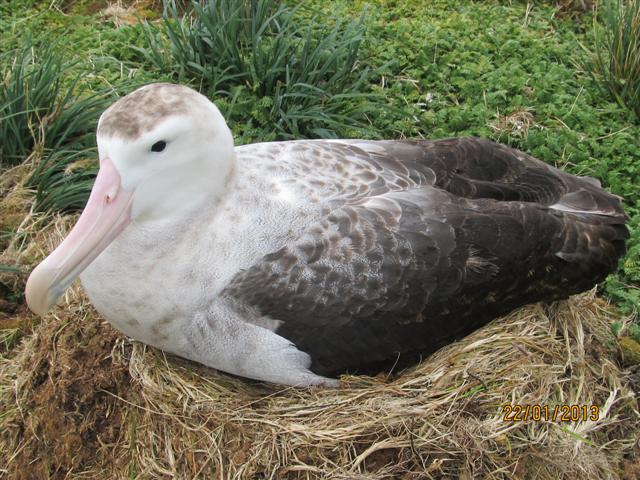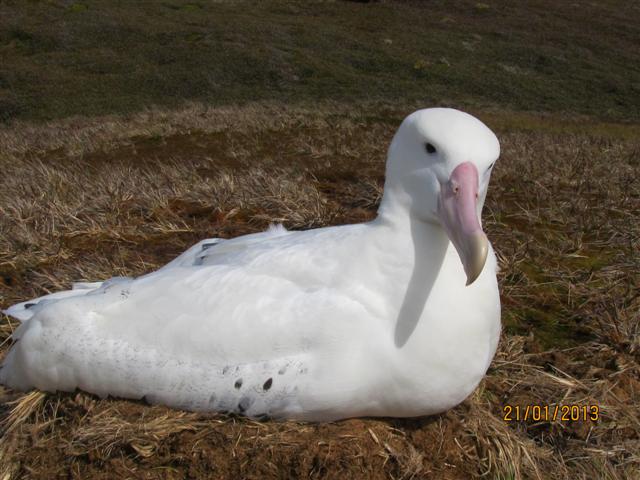Unlike the smaller albatrosses of the genera Phoebastria, Phoebetria and Thalassarche, the wandering group of albatrosses of the genus Diomedea undergo plumage changes with age. Back in the 1950s, John Douglas Gibson of the then New South Wales Albatross Study Group invented the “Gibson Code” or “Gibson Plumage Index” to to indicate plumage differences, using a simple numerical scoring system from 1 (mostly brown) to 6 (mostly white).
Subsequent studies have shown that for Wandering D. exulans, Tristan D. dabbenena, Antipodean D. antipodensis and Amsterdam D. amsterdamensis Albatrosses the smaller females tend to have more brown on them than do the males, although both genders whiten with age. According to French observations of banded birds of known age the last “snowy” stage of whiteness in Wandering Albatrosses is only reached by males that are over 30 years of age. However, according to a later study based on known-age birds from both Indian and Atlantic Ocean populations “[c]onventional (Gibson) plumage scores do not provide a reliable means of estimating age of Wandering Albatrosses, except in very general (3-5 year) categories.”
On Marion Island, the larger of the two South African Prince Edward Islands in the southern Indian Ocean, field researchers undertake annual “round-island” trips over several days counting every incubating Wanderer as they go to come up with a total population number for the island. This year the birds were counted by Linda Clokie who took occasion to photograph birds which represented much of the range set out in the Gibson Code – as illustrated here.


An assumed brown female and an assumed white male Wandering Albatross incubating on Marion Island in January 2013: representing the extremes of plumage in breeding birds at this locality. Photographs by Lionda Clokie
Linda also came across an incubating Wanderer bearing metal band J-00079 between Repetto’s Hill and Prinsloomeer on the island’s northern coast on 20 January. A check of the records showed that the bird was banded as a chick in the same region of the island on 2 November 1976 by Alan Burger, then of the University of Cape Town’s FitzPatrick Institute, making it the oldest known Wandering Albatross (at 36) of definite age on Marion Island.
Given that Wanderers have been recorded elsewhere to reach over 50 years of age, J-00079 could live for quite some more years yet. Let’s hope so!
Selected References:
Gibson, J.D. 1967. The Wandering Albatross Diomedea exulans: results of banding and observations in New South Wales coastal waters and the Tasman Sea. Notornis 14: 47-57.
Jouventin, P., Martinez, J. & Roux, J.-P. 1989. Breeding biology and current status of the Amsterdam Albatross. Ibis 131: 171-182.
Prince, P.A., Weimerskirch, H., Huin, N. & Rodwell, S. 1997. Molt, maturation and ageing in the Wandering Albatross. The Condor 99: 58-72.
Tickell, W.L.N. 2000. Albatrosses. Mountfield: Pica Press. pp. 132-133.
Weimerskirch, H., Lequette, B. &. Jouventin, P. 1989. Development and maturation of plumage in the Wandering Albatross Diomedea exulans. Journal of Zoology 219: 411-421.
With thanks to Linda Clokie and Peter Ryan for information and photographs
John Cooper, ACAP Information Officer, 21 February 2013

 English
English  Français
Français  Español
Español